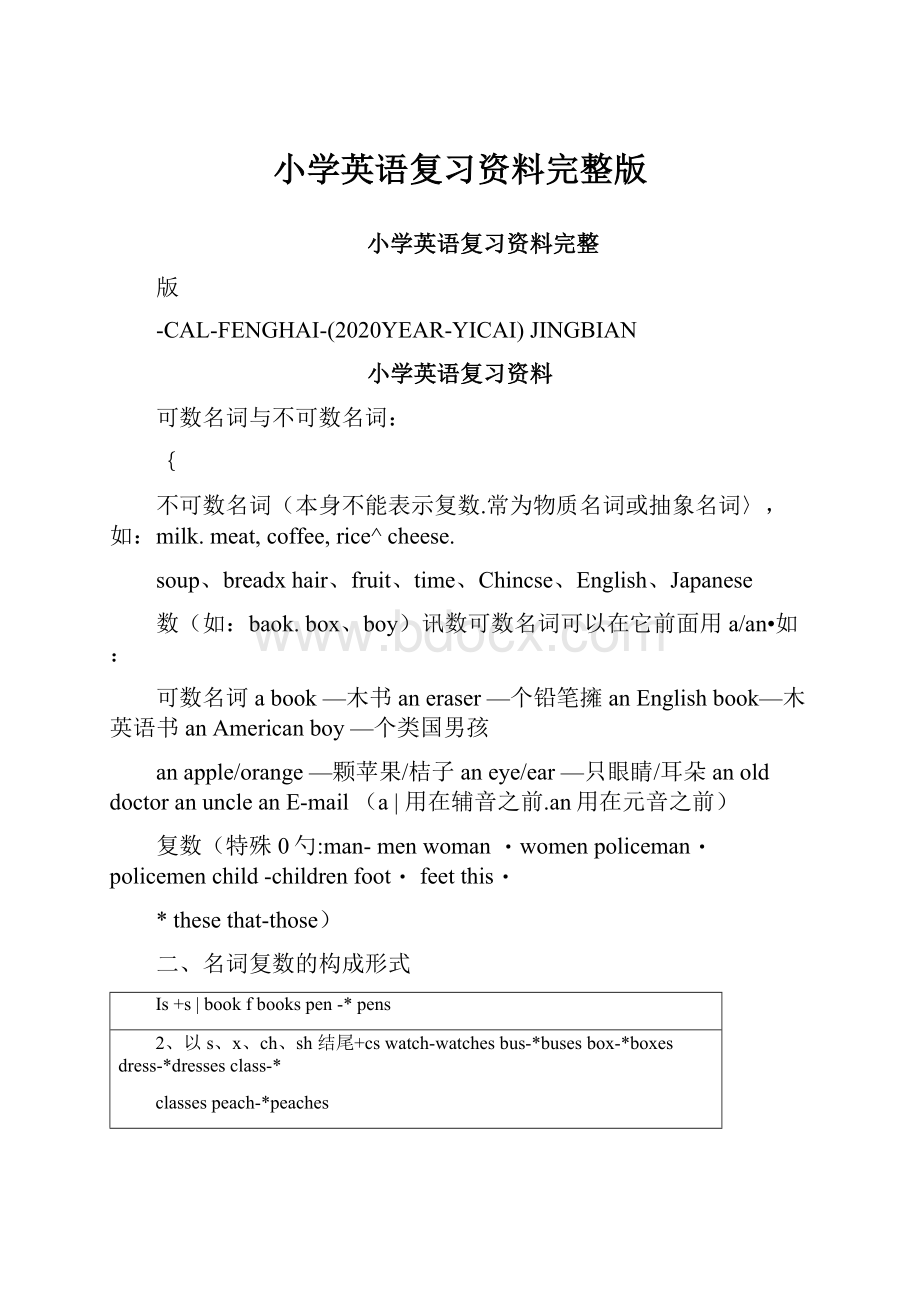小学英语复习资料完整版.docx
《小学英语复习资料完整版.docx》由会员分享,可在线阅读,更多相关《小学英语复习资料完整版.docx(26页珍藏版)》请在冰豆网上搜索。

小学英语复习资料完整版
小学英语复习资料完整
版
-CAL-FENGHAI-(2020YEAR-YICAI)JINGBIAN
小学英语复习资料
可数名词与不可数名词:
{
不可数名词(本身不能表示复数.常为物质名词或抽象名词〉,如:
milk.meat,coffee,rice^cheese.
soup、breadxhair、fruit、time、Chincse、English、Japanese
数(如:
baok.box、boy)讯数可数名词可以在它前面用a/an•如:
可数名诃abook—木书aneraser—个铅笔擁anEnglishbook—木英语书anAmericanboy—个类国男孩
anapple/orange—颗苹果/桔子aneye/ear—只眼睛/耳朵anolddoctoranuncleanE-mail(a|用在辅音之前.an用在元音之前)
复数(特殊0勺:
man-menwoman・womenpoliceman・policemenchild-childrenfoot・feetthis・
*thesethat-those)
二、名词复数的构成形式
Is+s|bookfbookspen-*pens
2、以s、x、ch、sh结尾+cswatch-watchesbus-*busesbox-*boxesdress-*dressesclass-*
classespeach-*peaches
3.以辅音字母+y结尾的名词,变“y”为r”再加es
story-*storiesfamily—familiesparty-*partiescountry-*countriesbaby-*babies(boy-*boysday-*days)
4、以f或fe结尾的名词,一般将f或fe变为v再加es
knife-*kniveshalf—>halvesleaf—>leaveswife—»wives
5、以F•结尾的名词+s或es(以辅音+o+esf以元音+o+s)
(photo「photos)zoo—*zoostomato—*tomatoesmangomangoes
6、不规则变化
child—*childrenfool—>feettooth—teethpoliceman—policementhis—>thesethat—»those
7、单复数一样
ChinesesheepfishJapanese
8、本身表复数
Peoplefivepeople(五个人)
三、主要人称代词、物主代词的基本用法。
1、人称代词的数与格:
数
单数
复数
主格
宾格
主格
宾格
第一人称
I我
me我
we我们
us我们
第二人称
you你
you你
you你们
you你们
第三人称
he他
him他
他们
他们
she她
her她
they她们
them她们
il它
il它
它们
它们
2、物主代词:
表示所有关系,分名词性物主代词和形容词性物主代词c
人、
形容词性物主代词
单数
复数
第一人称
my我的
our我们的
第二人称
your你的
your你们的
第三人称
his他的
他们的
her她的
their她们的
its它的
它们的
四、表示时间、地点、方位介词的用法:
1、介词亚的用法:
A:
用在几点钟之前。
eg:
MrLiugetsupatsixo'clock.
B:
在“nighr前用atoeg:
Themonkeysaretiredatnight.
C:
表示空j可,在….eg:
Let,smeetatthebusstopatfiveo,clock・
D:
表示地点:
athomeatschoolatthebusstop・
2、介词in的用法:
A:
inthemoming/afternoon/evening・
B:
"in"在…里面。
inthegardeninthebox.
C:
"in”是用的意思,eg:
inEnglish*••inChinese
3、介词on的用法
A:
在时期几前,在星期几的上午、下午、晚上前用on。
eg:
LefsgotothezooonSunday,on
Mondaymonning・B:
在…之上,・-onthebox・onthedesk・Onthetree・
4、介词under的用法:
eg:
on/underthebox.Myballisunderthebox・
5、about大约,差不多;
Wehavebreakfastataboutseveneverymorning.我们每天早上大约7点钟吃早点。
6、near在……附近。
7、of-••…的teacherofEnglishthecapitalofBeijing
五、英语简单句的基本形式和表意功能。
eg:
What,sthis/thcit(inEnglish)
It,sa/an…
Whatcolorisit
It's…
Whoisthis/that/she/he
He/She/It/This/That/is--
You/They/Weare--
11m…
What‘sthetime/WhattimeisitIt'sfiveo'clock.
whereareyou?
m…
Whereateyoufrom
Weare/I,mfrom--・
Howmanygirls/boys/--・
IlikeEnglish.
She/HelikesEnglish.
Doyou/they/welikeEnglish?
She/He/Itdoesn'tlikebananas.
Yes,I/they/we/youdo.(No,I/they/we/youdon't)
Doesshe/helikeapples
Yes,she/hedoes・(No,she/hedoesen't)
He/She/It/This/Thatis…
You/They/Weare(not)…
I’m(not)…
Thereis/are(not)・・・
Is/Arethere--
六、第三人称单数作主语时谓语动词加乜円的用法,其规则变化与名词复数一样。
a.—般加冒。
like—likescome—omesb・谓语动词是以b、s、x、ch、sF结尾的加y。
go—goesdo_oes
c.谓语动词是以“辅音字母+y"结尾的先变“y”为“匚再加“cs"。
eg:
fly-flies
d.少数动词第三人称单数特殊变化:
be-ishave-has
eg:
1・Everyoneisintheclassroom・2.1t,stimeforclass・3.Myfartherhasbreakfastathomeeverymorning・4・It,stimetogotoschool.
七、定冠词与不定冠词的用法:
定冠词先①是特指谈话人双方都知道的“某人、某物、某事S例如:
Thebookisonthe
desk.②前面提到过的人或事。
例1、Hehastwo
冠询
children:
aboyandagirl.Theboy^snameisSam.ThegirfsnameisAmy.彳列2、Ihaveapen.Thepenisinmypenceilcase・
不定冠词“a”“an”用在单数名词之前,表示的数量是“一个”,a用在辅音音素之前,an用在
元音音素之前,eg:
anegganapple.
基本基数词:
1one2.two3.three4.four5.five6.six7.seven8.eight9.ninelO.ten
基本序数词:
first=1stsecond=2ndthird=3rdfourth=4thfifth=5thsixth=6thseventh=7th
eighth=8thninth=9thtenth=1Oth
九、someany的用法:
1、它们既可修饰可数名词也可修饰不可数名词。
2、some用于陈述句肯定句中;any用于陈述句的否定句中和一般疑问句中。
eg:
1Thereissomemilkintheglass・
2Therearesomeflowersonthedesk・
3Thereisn"tanymilkintheglass・
4Arethereanyflowersonthedesk
Yes,thereare
No,therearen't(any)・
3、some用于委婉语气问句中。
eg:
WouldyoulikesomecoffeeYes,please./NoJhanks,Fdlike..・
十、功能:
(1)问候告别感谢致歉介绍请求等交际功能的基本表达形式。
1、问候:
初次见面问好:
A:
Howdoyoudo?
你好吗?
B:
Howdoyoudo?
你好吗?
2、已相识见面问候:
A:
Howareyou?
你好吗?
B:
Fmfine.thankyou.andyou/Fine,thanks,andyou我很好,谢谢你。
你好吗?
C:
Fmfine,too.我也很好。
3、早上见面问候:
A:
Goodmorning!
早上好B:
Goodmorning!
早上好
4、下午见面问好:
A:
Goodafternoon!
下午好!
B:
Goodafternoon!
下午好!
5、晚上见面问好:
A:
Goodevening!
晚上好!
B:
Goodevening!
晚上好!
6、
(1)很高兴见到你:
A:
Nice/Gladtomeetyou.B:
Nice/Gladtomeetyou.
⑵告别:
1、A:
Good-bye/Bye/Bye-bye!
再见!
B:
Good-bye/Bye/Bye-bye!
再见!
2、A:
Goodnight!
晚安!
B:
Goodnight!
晚安!
3、A:
Seeyoutomorrow/later!
明天见!
B:
Seeyoutomorrow/later!
明天见!
4、A:
Seeyou!
再见!
B:
Seeyou!
再见!
(3)表示感谢:
1、A:
Thankyou(verymuch)/Thanks.谢谢。
B:
That,sallright./ThatOK•不用谢。
2、A:
Thankyou(verymuch)/Thanks.非常感谢。
B:
Yoifrewelcome.不客气。
(4)表示歉意:
1、A:
『msorry.非常抱歉。
B:
Thafsallright./That^OK.没关系。
2、A:
Sorry.对不起cB:
That,sallright./That,sOK.没关系。
(5)询问别人:
1、A^hat^syourname?
你叫什么名字?
B:
Myname's…我叫
2、A:
Whereareyoufrom?
你来自哪儿?
B:
厂mfrom--我来自
3、A:
Who,sthis?
这是谁?
B:
ThisisMr/Ms/Miss这是先生/小姐
4、A:
Howdoyoudo你好吗B:
Howdoyoudo你好吗
5、A:
Nice/GIadtomeetyou.见到你很高兴。
B:
Nice/Gladtomeetyou,too见到你也很高兴。
⑹请求:
1、A:
MayIcomein?
我可以进来吗?
B:
Yes,please.请进。
或Sorry,youcan*t对不起,你不能进来。
2、A:
Can/CouldIuseyourpen?
我可以借一下你的钢笔吗?
B:
Yes,please./Yes,youcan是的,可以。
或Hereyouare.给你。
或Sorry,youcan*t对不起,你不能。
3、A:
CanIhelpyou?
我能帮助你吗?
B:
Yes,please./No,thanks.是的,可以。
/不,谢谢。
(7)介绍:
Mynameis…I'm•••
I*mfrom--ThisisMr/Ms/Miss---
十一、话题:
理解与表达有关下列话题的简单信息:
颜色、家庭、数字、时间。
1、颜色
A:
Whatcolorisit?
B:
It'sred/yellow/blue/white/green/black/pink/purple--
2、家庭
A:
Goodmorning!
B:
Goodmorning!
A:
What'syournameB:
Myname*s-Andthisismyfather(爸爸)
A:
Who'sthat
B:
She‘smymother(妈妈)
A:
Nicetomeetyou.
B:
Nicetomeetyou,too.
3、数字
A:
Howoldareyou
B:
I'mseven.
A:
Whatclassareyouin
B:
I'minClassThree,GradeSix.
A:
What'syourphonenumber
B:
It,S7654321
A:
Whereareyou
B:
I'monthesecondfloor.
4、时间
A:
What'sthetime
B:
It?
seighto'clock・
A:
WhattimeisitB:
It‘sfouro'clock・
A:
WhattimedoyougotoschoolB:
Igotoschoolatseven.
十二、语言技能。
英语26个字母的大写、小写、标点符号,句首单词第一个字母的正确书写。
1、英语26个字母的正确书写。
2、标点符号。
英语要有标点符号‘句号是(小黑点)
3、句首单词第一个字母的正确书写。
句首单词第一个字母必须大写。
十三、文化意识:
1、主要英语国家的国名和国旗及重要标志物。
(1)国名:
中国China英国England美国America(USA)
(2)标志物:
英国大本钟BigBen
2、中英文的第一个字母大写,如果是中文名字有三个字的,后两个字的拼音写在一起。
AmySamTomLinglingWangXiaopingZhangTaoSmartSmith
3、缩略词
USA美国UK英国W.C厕所CCTV中央电视台
WTO世界贸易组织TV电视CD光盘HK香港
十四、词汇:
1、冠词(art.):
a(an)—个(一只,把,台……)the表示特指的人、物、事》
2、数词(num.):
基数词:
onetwothreefourfivesixseveneightnineten
123
456
789
10
序数词:
firstsecond
thirdfourthfifth
sixthseventheighth
ninthtenth
第一第二
第三第四第五
第六第七第八
第九第十
3、名词:
(n.)
bag书包
book书
desk书桌、课桌
chair椅子
pen钢笔
pencil铅笔
pencilcase文具盒
eraser铅笔(黑板)擦
class班级、课、上课grade年级school学校
gotoschool上学
afterschool放学
Classb3/ClassThree3班
Grade6/GradeSix6年级ball球
football足球
basketball篮球
picture图片、照片
Photo相片、照片
map地图phone电话(机)kite风筝bike自行车
playbasketball打篮球bed床box盒子house房屋
door门floor(室内)地、地板flower花clock钟
o*clock■•-点钟(用于正点)colo(u)r颜色gotobed去睡觉
threeo'clock三点整Whatcolo(u)r什么颜色time时间
half半、一半(复数halves)day天、白天、一曰night夜、夜间
age年龄birthday生日morning早上、上午
afternoon下午、午后evening晚上、傍晚、黄昏fastfood快餐
breakfast早餐dinner晚餐、正餐Happybirthday!
生曰快乐!
freetime空闲、业余时间havebreakfast吃早餐havedinner吃晚餐
work工作
home家China中国
Beijing北京
England英国
London伦敦
America美国
E-mail电子邮件
WashingtonD.C华盛顿、哥伦比亚特区
inthemorning/afternoon/evening下午、晚上game游戏
Chinese中文、中国人(的)
English英语,英国人(的)
American美国人
gotowork(去)上班
gohome回家
playcomputergames玩电子游戏
ear耳朵eye眼睛nose鼻子hand手foot脚(复数feet)
hair头发hat帽子cap帽子dress连衣裙、套裙
fruit水果apple苹果banana香蕉orange橘子、柑
4、代词:
(pron.)
I我
me我
we我们
us我们
you你
you你
you你们
you你们
he他
him他
他们
他们
she她
her她
they她们
them她们
It它
it它
它们
它们
my我的
our我们的
his他的
their他们的
your你的
your你们的
her她的
their她们的
WTO世界贸易组织TV电视
CD光盘
HK香港
this这,这个
that那,那个
all全体、大家、都
everyone每人、人人
allright好、行、不错
That'sallright不用谢、没关系
what什么
who谁
5、动词(v.)
am是is是
are是
I'm=I
am我是ask问
answer回答
do做、干,行动;aux(构成否定、疑问句的肋动词)
does做、干,行动;
(do的第三人称单数形式)draw画write写,书写
spell拼写
learn学
run跑
read阅读、看(书)
sing唱、唱歌
dance跳舞
come来
go去
readabook看书
work工作
come
in请进,进来
clean把…弄干净、擦
close关
open打开
watch观看
watchTV看电视
find找到
use使用
play玩、玩耍
look看lookat看一看…
listen听
Listento听…(讲)
like喜欢have有、吃、饮
has有、吃、
饮(have的第三人称单数)
help帮助please请know知道,了解
Idon'tknow我不知道
Isee.我明白Isee…我看到…
let允许、让
let*s二letus让我
excuseme请原谅
getup起床
sit
down,please请坐
standup,please请起立thank谢谢
thanks二thankyou谢谢
canv.aux能,可以;
会couldv.
aux能,可以;
会colo(u)r着色
6、形容词:
(adj.)
black黑色的blue蓝色的
green绿色的
orange橘红色的
12
its它的
their它们的
Howmanyboys/girlsarethere?
有多少个男孩/女孩?
7、介词(prep.)
about大约
aboutseveno'clock大约7点钟at在(点刻)
8、副词(adv.)
not(构成否定形式)不是no(N。
否定回答)不、不是yes(Yes肯定回答)是,是的now现
在where哪里(用于疑问句表示问地点)here这里Hereyouare.给你
9、感叹词(int.)
ThafsOK.不用谢、没关系
Bye再见Hello喂Hi嗨OK
10、连词(conj.)
and和,又,而且
十五、基本句型
(一)、陈述句(肯定/否定式)
(二)、一般疑问句(需要用Yes和No回答的句子)特征:
句首有Be动词(Am/IS/Are)助词Do/Does情态动词Can…
1、Isthisakite
Yes,itis.No,itisn't
2XAmIateacher
Yes,youare・No,youaren?
t
3、Aretheyapples
Yes,theyare・No,theyaren?
t
4、DoyoulikeEnglish
Yes,Ido.No,Idon't
5、DoesheknowChinese
Yes,hedoes.
No,hedoesn't
6、Canyouspellyourname
Yes,lean.
No,Icant
7、Arethereanytreesinthepark
Yes,thereare・No,therearen?
t
(三)、特殊疑问句(句首有疑问词What,Who,How,Where……)
1、Wha